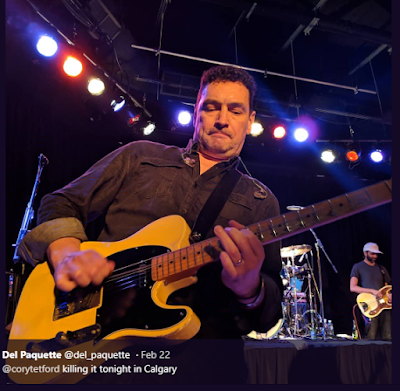I thought the post I wrote 'Alan Doyle And Friend's Fundraising Video 2018...published 16 January, 2018' needed a repost for Throwback Thursday for the anniversary so here it is.
I have circulated the totally awesome music video on my Google + page for those fans interested...
All the best to John Mann and his family and friends always...
'Alan Doyle And Friend's Fundraising Video 2018...published 16 January, 2018'
During November 2017, 'The Spirit of Canada A Benefit' brought together approximately 50 of Canada's best artists and musicians (including Alan Doyle, Jim Cuddy, Sarah McLachlan and Ed Robertson) to help raise funds for one of their own John Mann. The benefit was held on Sunday, 19 November, 2017 at the Commodore Ballroom in Vancouver, British Columbia.
The event was held to help raise funds for his medical condition (who was diagnosed with the early onset of Alzheimer's) and personal needs. During that night Alan Doyle and friends recorded a cover version of the Spirit of the West song 'Home For a Rest' and made a video that shows Mann enjoying the night dancing on stage while friends perform the song. The video was shared on social media and through the traditional media to help raise awareness and funds. The video is totally awesome and I wish them all the best.
Alan did some interviews about the experience of doing the fundraiser and recording the song and making the video. I decided to let Alan's words speak for themselves and have copied an interview from CBC Newfoundland and Labrador below. I have shared a copy of the 'Home For a Rest' video from YouTube on my Google + page. I have also shared some screen shots I have done from the video. As always no copyright infringement intended.
"We got it in the can in the can': Alan Doyle spearheads bathroom recording to benefit John Mann." published on 14 January 2018.
Track recorded in restroom during benefit show for Spirit of the West front man who has Alzheimer's.
A new version of a Spirit of the West hit was recorded in a restroom before a Vancouver gig to support ongoing care for the band's lead singer, who is living with early onset Alzheimer's.
"We got it in the can in the can," said singer-songwriter Alan Doyle of the recording, which came together with the help of other Canadian musicians at the Nov. 19 benefit show at the Commodore Ballroom.
"'I knew when that gig was coming up, that it was going to be a special day," Doyle told Weekend AM about the show in support of John Mann, who was diagnosed in 2014 at the age of 52.
In order to have something from the benefit that would last beyond the event itself, Doyle planned a recording of one of the band's best-known songs, Home For A Rest.
Doyle and members of his touring band laid down a bed track while in Halifax for a gig, and vocals — and a video — were recorded at the Commodore ballroom on the day of the show itself with dozens of the musicians who played on stage later that evening.
Doyle a longtime fan
Doyle has a long history with Mann and Vancouver-based Spirit of the West as a solo musician and as a member of Great Big Sea.
But his introduction to the band actually came from Much Music in the late 1980s. Doyle said he was excited to see music videos from a band playing the traditional instruments he was familiar with in an entirely new way.
"The first band that we knew in Canada that was getting on television, and even getting on the radio, and playing acoustic instruments really aggressively and punky was Spirit of the West," Doyle said of the band, which he described as a huge influence on him as a young musician.
"The way they chose to play very, very, delicate, fragile acoustic Celtic instruments was incredible to me," Doyle said. "It was very influential, yeah, probably one of the most influential bands of my lifetime."
'A show of love and support
The musical tribute to one of the band's biggest hits was planned around the November show, which Doyle described as "a night of entertainment, as a show of love and support and fundraising for John and his ongoing care."
With the bed track already recorded, Doyle and audio engineer Peter Green set up shop in a second-floor men's washroom at the venue, bringing musicians in and out during pre-show rehearsals to record on a mic lent by famed music producer Bob Rock, who was in town working on another project.
The unusual lavatory location for vocal recording was selected because it was enclosed, quiet and as far as possible from the rehearsal space, Doyle said.
"We did drape it nicely. We found a bunch of black drapes to put over the urinals and the like," Doyle said. "We had Sarah McLachlan coming in there. I couldn't ask Sarah to go to just any old men's can to sing a song."
Along with Doyle and McLachlan, the Home For A Rest cover includes Jim Cuddy (Blue Rodeo), Ed Robertson (Barenaked Ladies), Barney and Dustin Bentall, Colin James, and Craig Northey (Odds).
Geoffrey Kelly and Tobin Frank from Spirit of the West also played, along with some of the band members' children.
A GoFundMe page set up to support Mann and his family as his disease progresses and the amount of care he requires increases had surpassed its goal after raising $22,567 as of Friday.
As for Mann himself, Doyle said he was at the show and appeared to enjoy the evening.
"He just kept saying to me that it was lovely, the whole day was lovely," Doyle said. "Anything that keeps him connected to his friends and his musical friends that love him is good."
































